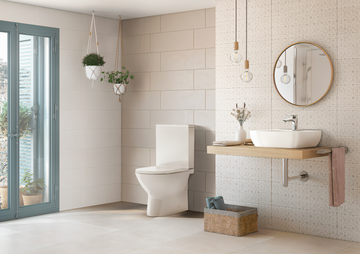Tiling a bathroom wall with large tiles can generate a stunning and streamlined look, enhancing the overall appearance of your space. If you're asking how to tile a bathroom wall with large tiles, youre not alone. Many homeowners and DIY enthusiasts seek solutions that not only improve aesthetics but also offer durability and low maintenance. In this article, we'll delve into the nuanced process of tiling a bathroom wall with large tiles. Well cover everything from preparation to finishing touches that will make your project shine.
Working with large tiles can pose unique challenges but can also yield significant rewards. Larger tiles create fewer grout lines, leading to a cleaner look and less surface area prone to mold and mildew. By following the right techniques, you can transform your bathroom into a beautiful oasis.

Why Choose Large Tiles?
One of the first questions you may have is, 'Why choose large tiles?' Here are some benefits:
- Fewer Grout Lines: The primary advantage of large tiles is reduced grout lines, which means less maintenance.
- Modern Aesthetic: Large tiles offer a sleek and contemporary look that can elevate any bathroom.
- Quicker Installation: Fewer tiles mean fewer cuts and less time spent installing.
- Versatility: Large tiles come in various materials and designs, making them suitable for all styles.
Preparing for Installation
Before you take the plunge and begin your tiling project, preparation is key. Here are some essential steps to consider in your planning stage:
Step 1: Gather Your Materials
You'll need the following materials: ceramic or porcelain large tiles, tile adhesive, grout, a trowel, a tile cutter, and spacers. You can find more details on tile thickness which is essential in your material choice.
Step 2: Measure the Wall
Accurate measurements are critical for planning your tile layout. Measure the height and width of the wall area to be tiled. Calculating the total square footage will help you determine how many tiles you need to purchase.
Step 3: Prepare the Surface
Make sure the wall surface is clean, dry, and free of any loose materials. If it's a new wall, ensure it's flush and level. For existing walls, check for any damages that might need repairs.
Setting Your Tiles
Step 4: Layout Planning
Consider laying out the tiles on the floor before adhering them to the wall. This practice helps visualize the pattern and identify any necessary cuts in advance.
Step 5: Applying Adhesive
Using a notched trowel, spread the tile adhesive evenly on the wall. Start from the bottom and work your way up, applying only as much adhesive as you can cover with tiles within a given time frame.
Step 6: Tile Placement
Begin placing your tiles, pressing them firmly into the adhesive. Use spacers to ensure even spacing between each tile, and check for levelness as you go.
Finishing Touches
Step 7: Grouting
Once the tiles are set and the adhesive has cured, remove the spacers and prepare to grout. Use a grout float to apply grout between the tiles, ensuring all gaps are filled. Wipe excess grout from the tile surface with a damp sponge before it dries.
Step 8: Sealing
After allowing the grout to cure, its wise to apply a sealer. This step protects against moisture and stains, prolonging the life of your tiling work.
Step 9: Final Cleaning
Once everything is dry, clean the tiles thoroughly to remove any residue. This final touch will ensure your tiles look immaculate.
Common Mistakes to Avoid
Tiling can be daunting, and common mistakes can easily derail your project:
- Not Planning: Skipping the planning phase often leads to errors and a need for additional materials.
- Ignoring Levelness: If your tiles are not level, the finished look can appear unprofessional.
- Rushing the Grouting: Taking your time during grouting ensures a neat and clean finish.

FAQ Section
What type of large tiles are best for a bathroom wall?
Ceramic or porcelain tiles are popular choices for bathroom walls due to their water resistance and variety of designs.
How do I prepare my bathroom walls for tiling?
Ensure the walls are clean, dry, and level. Repair any damages and prime if necessary.
Can I tile over existing tiles?
Yes, you can tile over existing tiles, but ensure the surface is sound and level for proper adherence.
For more tips, check out tile tips that can make your project easier.
As an Amazon Associate, I earn from qualifying purchases.






